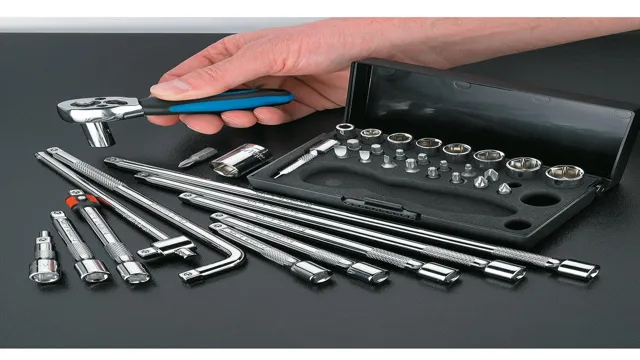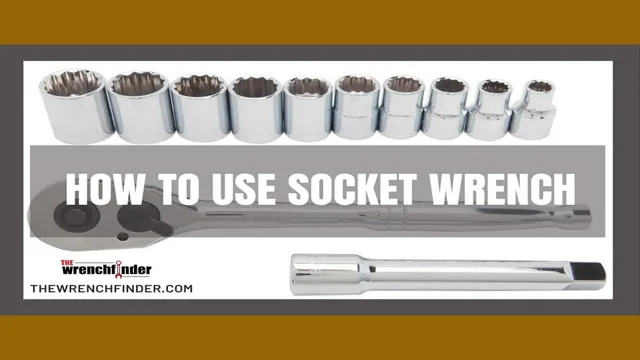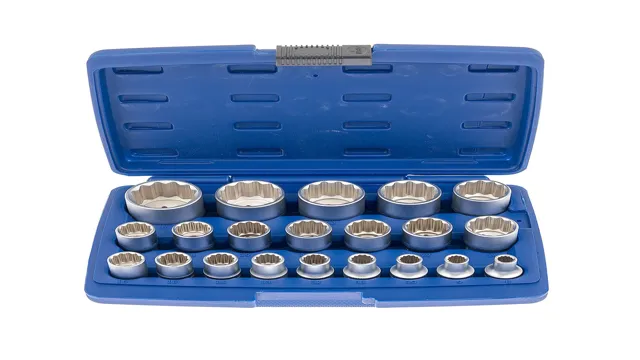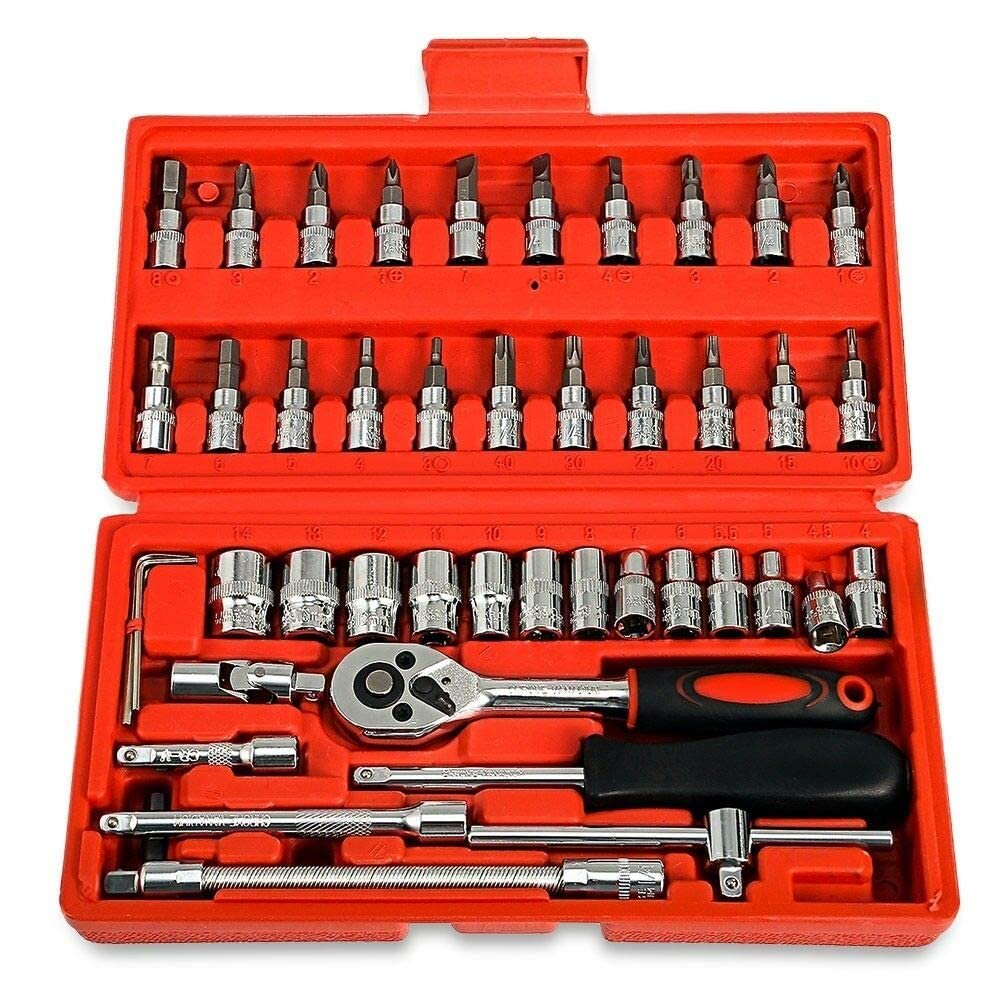How to Use a Socket Wrench Set: A Comprehensive Guide for Beginners

If you’re a DIY enthusiast or a professional mechanic, using a socket wrench set can make any job easy and efficient. From loosening tight bolts to tightening nuts, the set provides a wide range of socket sizes to fit different fasteners. A socket wrench set usually consists of a ratcheting wrench and interchangeable sockets that come in various shapes to fit hexagonal, square, and Torx bolts.
It’s an excellent investment that can save you time and effort while working on a project. But, do you know how to use a socket wrench set correctly? In this blog post, we’ll explore some practical tips on using a socket wrench set and how it can help you tackle any job with ease.
What is a Socket Wrench Set?
Are you wondering how to use a socket wrench set? Well, first, let’s talk about what a socket wrench set is. A socket wrench set is a collection of tools used to tighten or loosen bolts and nuts. It includes a ratcheting handle and various sizes and types of sockets that fit over the bolt head or nut depending on the size and shape.
To use a socket wrench set, start by selecting the appropriate socket size for the bolt or nut that needs to be tightened or loosened. Insert the socket onto the ratcheting handle and place it over the bolt head or nut. Apply force to the handle in the direction you need the bolt or nut to move.
That’s it! With a little practice, you can master the use of a socket wrench set and tackle all kinds of DIY projects around your home.
Definition and Purpose
A socket wrench set is a versatile tool that consists of a handle and various detachable sockets of different sizes designed to fit various fasteners. The sockets have a hexagonal shape, and the handle has a ratcheting mechanism that allows it to turn in one direction only. This tool has become increasingly popular among DIY enthusiasts and professionals alike due to its effectiveness and ease of use in tightening or loosening bolts and nuts.
The purpose of a socket wrench set is to provide the user with a convenient and efficient way to adjust mechanical components. This tool is especially useful when dealing with bolts or nuts that require a lot of torque. With the right socket size, the user can change the socket quickly and switch to another size without having to search for another tool.
A Socket wrench set can be a very useful and powerful tool in your toolbox, and it will always save the day when you need to make quick fixes around the house or garage.

Types of Socket Wrench Sets
If you’re new to using socket wrench sets, it can be challenging to understand the different types and their uses. One common type is the standard socket wrench set, which features sockets of various sizes to fit different bolt heads. These sets typically include a ratchet wrench that allows you to easily tighten and loosen bolts.
Another type is the deep socket wrench set, which has longer sockets that can reach nuts and bolts in deep crevices. This type is especially useful for automotive repairs. Yet another variation is the impact socket wrench set, which features thicker sockets designed to withstand the high torque produced by impact wrenches.
When selecting a socket wrench set, consider the size and types of nuts and bolts you’ll be working with and the level of torque required. With some practice and knowledge of the different types of socket wrench sets, you’ll be able to handle any job smoothly and efficiently.
Metric vs. SAE
Socket wrench sets come in two main types, metric and SAE. The difference between the two lies in the measurement system they use, with metric using millimeters and SAE using inches. When choosing a socket wrench set, it’s essential to consider the tasks you’ll be performing and the measurements of the nuts and bolts you’ll be working with.
Metric sets are typically used in automotive and industrial settings, while SAE sets are more commonly used in construction and woodworking. It’s also crucial to ensure that the wrench and socket sizes match the fastener size, as using the wrong size can cause damage or stripping. Ultimately, the choice between metric and SAE comes down to personal preference and the specific needs of the job at hand.
Impact Wrench vs. Standard Wrench
When it comes to loosening or tightening bolts or nuts, having the right tool for the job is essential. One of the most common types of socket wrench sets is the standard wrench. This type of wrench works by utilizing a lever to increase the torque and loosen or tighten fasteners.
On the other hand, an impact wrench uses compressed air to generate a high amount of torque that can quickly manage even the most stubborn bolts. While standard wrenches are perfect for smaller jobs or tight spaces, impact wrenches are ideal for heavy-duty tasks that require a lot of power. When selecting a socket wrench set, it’s essential to consider the size and type of bolts or nuts that you’ll be working with to ensure you have the right tool for the job.
With the right socket wrench set, you can tackle any job with ease and accuracy.
Steps on How to Use a Socket Wrench Set
If you’re looking to tackle some DIY projects or make repairs on your car, learning how to use a socket wrench set can be incredibly helpful. To start, select the correct sized socket for the job by matching it to the bolt you need to tighten or remove. Attach the socket to the ratchet firmly, making sure it is secure.
You can then use the ratchet to either tighten or loosen the bolt, depending on your needs. Remember to use the right amount of force and to follow safety guidelines, including wearing gloves and safety glasses, particularly when working with sharp or heavy objects. Practice with your socket wrench set until you feel confident in your abilities, and don’t be afraid to seek out additional guidance or resources if you need them.
With a little bit of time and practice, you can become a pro at using this handy tool.
Step 1: Identify the Socket Size
Using a socket wrench set can be beneficial in tightening or loosening bolts and nuts with ease. However, it is important to know the proper steps on how to use it. Step one is identifying the socket size needed for the specific job.
The sockets are designed to fit specific bolt or nut sizes, so it’s essential to match the socket to the size required. Most socket sets come with a range of sizes from small to large. To identify the correct size, check the bolt or nut head and find one that matches the size.
Using the wrong socket size can damage the bolt and compromise the integrity of the connection. Therefore, taking the time to ensure the socket size matches the bolt is crucial before using a socket wrench set.
Step 2: Attach the Socket to the Wrench
One of the essential steps to effectively using a socket wrench set is attaching the socket to the wrench. After selecting the appropriate socket size for the task at hand, match it to the wrench drive size. Press and hold the button at the top of the wrench to release the current socket and then slide the new socket onto the drive until it clicks into place.
Ensure that the socket is firmly attached to the wrench to avoid slipping and potential injuries. It is crucial to check that the socket is compatible with the fastener to be turned before proceeding to the nuts or bolts. Finally, confirm that the socket is correctly positioned on the fastener and begin tightening or loosening it as necessary.
By following these simple steps, you can use a socket wrench set efficiently and quickly complete your projects without any setbacks.
Step 3: Place the Socket on the Nut or Bolt
When using a socket wrench set, there are a few steps you need to follow to ensure proper usage. After selecting the appropriate socket size, the next step is to place the socket onto the nut or bolt you want to remove or tighten. Align the socket with the nut or bolt and make sure it fits properly.
You don’t want to end up damaging the fastener or the socket. Once the socket is in place, press it down firmly onto the nut or bolt. Make sure it’s secure before applying any force.
A loose socket can result in slipping, causing damage to the fastener or your hand. The key is to take your time and be careful. Once you’re confident the socket is securely in place, you can proceed to tighten or loosen the nut or bolt with your socket wrench.
Remember to pay attention to the amount of force you’re applying so you don’t over-tighten or under-tighten the fastener. With these steps, you’re well on your way to using a socket wrench set with ease.
Step 4: Turn the Wrench
To turn the wrench, ensure it’s placed on the nut or bolt you want to tighten or loosen. Then, use the handle to move the socket in either a clockwise or counterclockwise direction depending on what you want to achieve. Be sure to avoid rocking the wrench back and forth as you may damage the bolt or nut.
Additionally, don’t apply too much force or torque on the wrench as it may also cause harm. Instead, apply steady pressure while keeping the tool parallel to the workpiece. As you grind the nut or bolt, hold the socket with one hand and the handle with the other to maintain control.
With these simple steps, you should now be an expert in using your socket wrench set. Enjoy your DIY projects with this handy tool!
Step 5: Remove the Socket From the Nut or Bolt
After you have tightened a nut or bolt, the next step is to remove the socket from it using a socket wrench set. This step is crucial to ensure that you can take the tool off successfully without running into any issues. To remove the socket, start by turning the wrench counterclockwise, using the same motion as when tightening the nut or bolt.
You’ll notice that the socket will start to loosen, and you can gently pull it away from the nut or bolt. Sometimes, the socket can become stuck on the nut or bolt, making it challenging to remove. In this case, try twisting the socket back and forth carefully to loosen it.
Remember to avoid pulling the socket directly as this can cause it to snap off the wrench, potentially damaging it. By following these steps, you’ll be able to successfully remove the socket, allowing you to move on to the next task at hand.
Safety Tips When Using a Socket Wrench Set
When it comes to using a socket wrench set, safety should always be a top priority. Before you get started, make sure to inspect each individual piece of the set for any signs of damage or wear and tear. It’s also important to choose the correct socket size for the job at hand, ensuring a secure fit to prevent slippage or rounding of the bolt or nut you’re trying to tighten or loosen.
When using a socket wrench, use a slow and steady motion, always keeping your grip firm and secure. If you’re working with particularly stubborn hardware, consider using a penetrating oil to help loosen things up before using your wrench. Finally, never use a socket wrench set on live electrical circuits or other potentially hazardous environments – always exercise caution and use your best judgment to stay safe and avoid injury.
By following these tips, you’ll be able to make the most of your socket wrench set while staying safe and minimizing the risk of accidents.
Use of Safety Glasses and Gloves
When using a socket wrench set, it’s important to remember the value of safety glasses and gloves. Safety glasses can protect your eyes from any debris or sparks that may fly off while tightening or loosening bolts, and gloves can prevent cuts or scrapes from sharp edges. It may be tempting to skip these safety measures, but they can make a significant difference in reducing the risk of injury.
Plus, it’s always better to be safe than sorry! So, before you start working with a socket wrench, make sure you have your safety glasses and gloves on. Your eyes and hands will thank you.
Proper Body Position
When using a socket wrench set, it’s crucial to maintain proper body position to prevent injuries and ensure optimal performance. First and foremost, always ensure that you’re working on a stable and level surface to prevent slips and falls. Additionally, maintain a firm grip on the tool and use your body weight to apply pressure rather than just your arms.
Keep your wrists straight and avoid exerting excessive force, as this can cause strains and sprains. Lastly, adjust your body position as needed to maintain good posture and reduce strain on your back and neck. By following these safety tips and adopting the right approach, you can work more efficiently and effectively with your socket wrench set.
Avoid Excessive Force
When using a socket wrench set, it’s essential to prioritize safety to avoid accidents. One critical safety tip to keep in mind is to avoid excessive force when tightening or loosening bolts. While it might be tempting to apply maximum pressure to get the job done quickly, too much force can lead to the tool slipping, causing harm or damaging the equipment.
Instead, use gradual and steady force until the bolt reaches the desired torque level. Remember that torque specs differ, with some requiring less force than others. So, be sure to have a torque wrench on hand to ensure you’re using the right amount of force.
By following this simple rule, you can avoid compromising your safety and the equipment you’re working on.
Conclusion and Final Thoughts
In conclusion, using a socket wrench set is like playing a game of chess. You have to strategize which socket size to use and where to place them to effectively tighten or loosen the bolt. It’s a classic case of brains over brawn.
So, grab your socket wrench set, plan your moves and let the tightening begin!”
FAQs
What is a socket wrench set, and how does it work?
A socket wrench set is a collection of tools that consists of a ratcheting wrench, extended handles, and a variety of interchangeable socket heads of different sizes. These wrenches work by attaching the socket heads to the handles, allowing them to loosen or tighten bolts and nuts with greater ease.
What sizes of socket wrench sets are available, and how do I know which one to use?
Socket wrench sets come in various sizes, usually starting from 1/4 inch and ranging to 1 inch. It is essential to use the correct size socket head to avoid damaging the bolt or nut or the wrench itself. To determine which size to use, you can refer to the owner’s manual or measure the diameter of the bolt or nut.
How should I clean and maintain my socket wrench set?
To maintain your socket wrench set, you should clean it after every use to prevent rust and dirt buildup. You can use a mild soap and water solution to clean the metal parts, followed by a dry cloth to absorb the moisture. It is also essential to store the set in a dry, clean place to prevent rust.
Can I use a socket wrench set on both standard (SAE) and metric bolts and nuts?
Yes, most socket wrench sets come with both standard (SAE) and metric sizes that can be interchanged depending on the bolt or nut you are working on. Be sure to choose the appropriate size and unit to avoid damaging the tool or the fastener.
Are socket wrench sets suitable for all types of bolts and nuts?
Socket wrench sets work well on bolts and nuts with a hexagonal or square-shaped head. Some sets may include specialty sockets designed for specific bolt or nut shapes, such as star-shaped or rounded edges.
How do I use the ratcheting function of a socket wrench set?
The ratcheting function of a socket wrench set allows you to turn the bolt or nut without having to reset the socket continuously. To use it, select the correct size socket head and attach it to the handle. Then, ensure that the ratcheting switch is in the right position by testing it on a non-critical bolt or nut. Once you are confident, you can use the ratcheting function to tighten or loosen the bolt or nut.
Can I use socket wrench sets on other types of fasteners besides bolts and nuts?
Socket wrench sets are ideally suited for bolts and nuts with hexagonal or square-shaped heads. However, some sets may have specialty sockets designed for different types of fasteners, such as screws and spark plugs. Be sure to check the manufacturer’s instructions or owner’s manual to ensure that your socket wrench set is suitable for the task.

